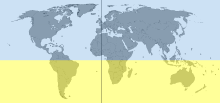Northern Hemisphere
Coordinates: 90°0′0″N 0°0′0″E / 90.00000°N 0.00000°E / 90.00000; 0.00000

Northern Hemisphere shaded blue. The hemispheres appear to be unequal in this image due to Antarctica not being shown, but in reality are the same size.

Northern Hemisphere from above the North Pole
The Northern Hemisphere is the half of Earth that is north of the Equator. For other planets in the Solar System, north is defined as being in the same celestial hemisphere relative to the invariable plane of the solar system as Earth's North pole.[1]
Owing to the Earth's axial tilt, winter in the Northern Hemisphere lasts from the December solstice (typically December 21 UTC) to the March equinox (typically March 20 UTC), while summer lasts from the June solstice (typically June 21 UTC) through to the September equinox (typically September 23 UTC). The dates vary each year due to the difference between the calendar year and the astronomical year.
Its surface is 60.7% water, compared with 80.9% water in the case of the Southern Hemisphere, and it contains 67.3% of Earth's land.[2]
Contents
1 Geography and climate
2 Demographics
3 List of continents
4 See also
5 References
6 External links
Geography and climate
The Arctic is the region north of the Arctic Circle. Its climate is characterized by cold winters and cool summers. Precipitation mostly comes in the form of snow. The Arctic experiences some days in summer when the Sun never sets, and some days during the winter when it never rises. The duration of these phases varies from one day for locations right on the Arctic Circle to several months near the North Pole, which is the middle of the Northern Hemisphere.
Between the Arctic Circle and the Tropic of Cancer lies the Northern temperate zone. The changes in these regions between summer and winter are generally mild, rather than extreme hot or cold. However, a temperate climate can have very unpredictable weather.
Tropical regions (between the Tropic of Cancer and the Equator) are generally hot all year round and tend to experience a rainy season during the summer months, and a dry season during the winter months.
In the Northern Hemisphere, objects moving across or above the surface of the Earth tend to turn to the right because of the coriolis effect. As a result, large-scale horizontal flows of air or water tend to form clockwise-turning gyres. These are best seen in ocean circulation patterns in the North Atlantic and North Pacific oceans.
For the same reason, flows of air down toward the northern surface of the Earth tend to spread across the surface in a clockwise pattern. Thus, clockwise air circulation is characteristic of high pressure weather cells in the Northern Hemisphere. Conversely, air rising from the northern surface of the Earth (creating a region of low pressure) tends to draw air toward it in a counterclockwise pattern. Hurricanes and tropical storms (massive low-pressure systems) spin counter-clockwise in the Northern Hemisphere.
The shadow of a sundial moves clockwise in the Northern Hemisphere (opposite of the Southern Hemisphere). During the day, the Sun tends to rise to its maximum at a southerly position except between the Tropic of Cancer and the Equator, where the sun can be seen to the north, directly overhead, or to the south at noon dependent on the time of year.
When viewed from the Northern Hemisphere, the Moon appears inverted compared to a view from the Southern Hemisphere.[3][4] The North Pole faces away from the galactic center of the Milky Way. This results in the Milky Way being sparser and dimmer in the Northern Hemisphere compared to the Southern Hemisphere, making the Northern Hemisphere more suitable for deep-space observation, as it is not "blinded" by the Milky Way.[citation needed]
Demographics
The Northern Hemisphere is home to approximately 6.57 billion people which is around 90% of the earth's total human population of 7.3 billion people.[5][6]
List of continents
- All of continental Europe
- All of North America, Central America and the Caribbean
- The vast majority of Asia, except part of Maritime Southeast Asia (which straddles the Equator)
- About 2⁄3 of Africa, just above the “horn”
- About 1⁄10 of South America, north of the mouth of the Amazon River
See also
- North Pole
- North–South divide
- South Pole
- Southern Hemisphere
References
^ Archinal, Brent A.; A'Hearn, Michael F.; Bowell, Edward G.; Conrad, Albert R.; Consolmagno, Guy J.; et al. (2010). "Report of the IAU Working Group on Cartographic Coordinates and Rotational Elements: 2009" (PDF). Celestial Mechanics and Dynamical Astronomy. 109 (2): 101–135. Bibcode:2011CeMDA.109..101A. doi:10.1007/s10569-010-9320-4.
^ Life on Earth: A - G.. 1. ABC-CLIO. 2002. p. 528. ISBN 9781576072868. Retrieved 8 September 2016.
^ Laura Spitler. "Does the Moon look different in the northern and southern hemispheres? (Beginner) - Curious About Astronomy? Ask an Astronomer". cornell.edu. Retrieved 10 November 2015.
^ "Perspective of the Moon from the Northern and Southern Hemispheres". Retrieved 22 October 2013.
^ "90% Of People Live In The Northern Hemisphere - Business Insider". Business Insider. 4 May 2012. Retrieved 10 November 2015.
^ "GIC - Article". galegroup.com. Retrieved 10 November 2015.
External links
![]() Media related to Northern Hemisphere at Wikimedia Commons
Media related to Northern Hemisphere at Wikimedia Commons

 Clash Royale CLAN TAG#URR8PPP
Clash Royale CLAN TAG#URR8PPP